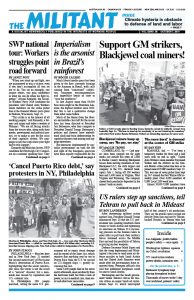October 10, 1994
FLINT, Michigan — Nearly 12,000 members of United Auto Workers Local 599, the largest General Motors local in North America, walked out of the 25 plants that make up GM’s Buick City complex September 27.
The strikers are protesting the company’s refusal to hire more workers while they impose massive overtime and speedup that is resulting in increased stress, exhaustion, and injuries.
GM has cut its U.S. workforce in order to be more competitive with Ford and Chrysler. One study showed that it takes about four GM workers per day to build one car, but only about three at Ford or Chrysler.
Many workers on the picket line said they were working six to seven days a week and nine to 12 hours a day. They said the speed on one line increased recently from 65 to 77 cars per hour.
October 10, 1969
While the Nixon administration is making a pretense of de-escalating the war in South Vietnam, it has been intensifying the U.S. attack on neighboring Laos.
Northern Laos has been murderously bombed since the beginning of the war in Vietnam. On Aug. 30, 1966, Senator J.W. Fulbright, Foreign Relations Committee chairman, told the Senate, “More than 1,500 bombing and reconnaissance missions are made each week from bases in Thailand into North Vietnam and the Communist-controlled corridor in Laos.”
Washington’s real objective in Laos is to devastate the region long held by the Pathet Lao. But the Pathet Lao isn’t a new enemy. Washington’s hostility to it goes back to the early 1950s and the crumbling of French colonial rule in Indochina.
October 7, 1944
Events in France today, where a rapidly reviving working-class is moving toward the battle-lines of the socialist revolution, are testimony both to the explosive state of class relations and the revolutionary tradition of the French workers. The movement of the workers may still be rather halting, but its direction is unmistakable. The establishment of workers’ committees, which have taken charge of many large industrial enterprises in the Paris area, is the clearest indication of the revolutionary trend.
The French workers’ struggles are a continuation of the revolutionary upsurge which began with the anti-fascist general strike of February 12, 1934, and the sit-ins and strikes of 1936-38.
The workers sought a solution on the field of revolutionary battle, but were sidetracked and betrayed by their “Socialist” and Stalinist leaders.

